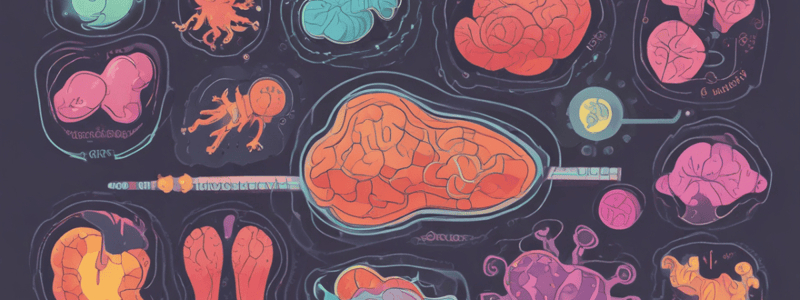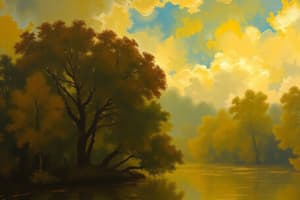Podcast
Questions and Answers
Which enzyme catalyzes the formation of 3-hydroxy-3-methylglutaryl-CoA (HMG-CoA) from acetoacetyl-CoA?
Which enzyme catalyzes the formation of 3-hydroxy-3-methylglutaryl-CoA (HMG-CoA) from acetoacetyl-CoA?
- 3-hydroxy-3-methylglutaryl-CoA lyase
- Acetyl-CoA carboxylase
- 3-hydroxybutyrate dehydrogenase
- 3-hydroxy-3-methylglutaryl-CoA synthase (correct)
What are the main products formed during the hydrogenation of acetoacetate?
What are the main products formed during the hydrogenation of acetoacetate?
- 3-hydroxybutyrate and NADH
- 3-hydroxybutyrate and water
- 3-hydroxybutyrate and NAD+ (correct)
- Acetone and acetyl-CoA
Where specifically does ketogenesis occur within the liver cells?
Where specifically does ketogenesis occur within the liver cells?
- Golgi apparatus
- Cytoplasm
- Endoplasmic reticulum
- Mitochondria (correct)
Which of the following compounds is a starting material for ketogenesis?
Which of the following compounds is a starting material for ketogenesis?
What is the primary ketone body found in blood and urine during ketosis?
What is the primary ketone body found in blood and urine during ketosis?
Which enzyme is responsible for the split of acetyl-CoA from HMG-CoA?
Which enzyme is responsible for the split of acetyl-CoA from HMG-CoA?
From which molecule does acetoacetate spontaneously decarboxylate to form acetone?
From which molecule does acetoacetate spontaneously decarboxylate to form acetone?
Which two molecules can condense to form acetoacetyl-CoA?
Which two molecules can condense to form acetoacetyl-CoA?
Flashcards are hidden until you start studying
Study Notes
Ketone Bodies
- Ketone bodies are produced by the liver under metabolic conditions with high fatty acid oxidation rates.
- Ketone bodies consist of acetoacetate, 3-hydroxybutyrate (β-hydroxybutyrate), and acetone.
Ketogenesis
- Ketogenesis occurs in the mitochondria of liver cells.
- Enzymes responsible for ketone body formation are 3-hydroxy-3-methylglutaryl-CoA synthase and 3-hydroxy-3-methylglutaryl-CoA lyase.
- Ketogenesis is an alternative way of fatty acid oxidation for energy production in extrahepatic tissues.
Biosynthesis of Ketone Bodies
- Acetoacetyl-CoA is the starting material for ketogenesis and can be formed from two acetyl-CoA molecules or directly from the terminal four carbon atoms of an acyl-CoA during β-oxidation.
- Condensation of acetoacetyl-CoA with acetyl-CoA forms 3-hydroxy-3-methylglutaryl-CoA (HMG-CoA) in the presence of water.
- 3-Hydroxy-3-methylglutaryl-CoA lyase enzyme splits acetyl-CoA from HMG-CoA, forming acetoacetate.
- Acetoacetate can be converted to other ketone bodies through hydrogenation to form 3-hydroxybutyrate or spontaneous decarboxylation to form acetone.
- 3-Hydroxybutyrate is quantitatively the predominant ketone body present in the blood and urine in ketosis.
Studying That Suits You
Use AI to generate personalized quizzes and flashcards to suit your learning preferences.




